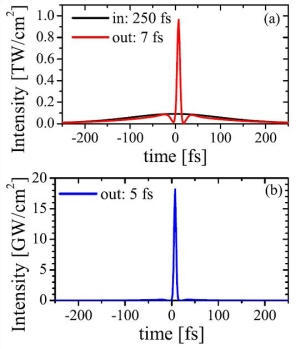Generating the shortest laser pulses in the world using ultra-fast femtosecond nonlinear effects
Contacts:
Morten Bache, DTU Fotonik, 4525-3775 (moba@fotonik.dtu.dk)
www.fotonik.dtu.dk/uno
 |
 |
| Upper: Proposed experimental setup for soliton compression of longer fs laser pulses from a high-power fs fiber laser. Lower: numerical simulation of propagation of a 250 fs pulse with wavelength 1030 nm in a quadratic nonlinear crystal eventually compressing to a 7 fs almost single-cycle IR pulse (a) and at the same time a visible 5 fs pulse is generated (b). |
The future demand of controlling, measuring and manipulating matter requires access to ultra-short femtosecond laser pulses. With such pulses one can perform extreme nonlinear optics experiments, challenging the current understanding of physics. We seek to develop a simple method for generating ultra-short fs laser pulses in the visible (λ=380-750 nm) and near-infrared (λ=750-1400 nm) regimes. The pulses must be generated with low-cost and stable equipment, using high-power fiber lasers as source and a single quadratic nonlinear crystal as compression medium. The compression occurs due to solitons; these are nonlinear waves where dispersive effects are counteracted by nonlinear effects. Studying femtosecond solitons requires deep control over all kinds of linear and nonlinear effects. The system can generate some of the shortest pulses ever observed (a few optical cycles), and the light covers hundreds of nm of bandwidth.
To the left is shown a cartoon of the proposed setup: a high-power fs laser provides >>100 fs pulses that are suitably defocused by a lens in a quadratic nonlinear crystal. Inside the crystal solitons are generated that compress at the exit. The numerics show (a) compression from 250 fs to 7 fs in the IR (λ=1030 nm). At the same time an incredibly short 5 fs visible pulse is generated (λ~600 nm).
Recently an accurate theory was developed at Fotonik, which explains cascaded SHG as a nonlocal (delayed) cubic nonlinearity. It has many analogies to Raman effects in silica fibers, and actually GVM is responsible for the Raman-like nature of the nonlinearity. Further theoretical and numerical understanding of this topic would be extremely interesting, and also extension of the theory to other quadratic processes would be relevant.
The project is theoretical and numerical. You will work on understanding the physics behind the compression process and will perform realistic numerical simulations of extreme nonlinear interaction of femtosecond optical beams. You can also carry out related projects, such as the ones listed here.